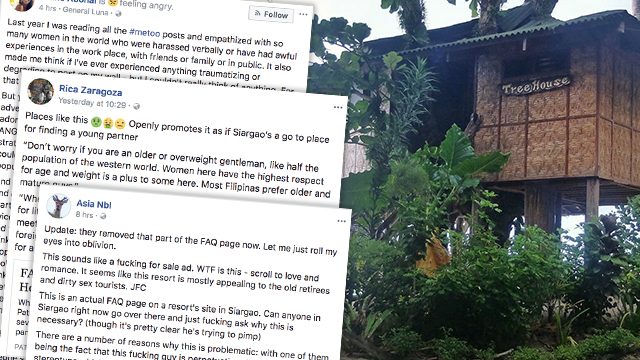SUMMARY
This is AI generated summarization, which may have errors. For context, always refer to the full article.

MANILA, Philippines – A resort in Siargao drew flak from netizens on Tuesday, January 30, after their page – which marketed the island as a go-to place for foreigners looking for “lifetime partners” – circulated online.
“Don’t worry if you are an older or overweight gentleman, like half the population of the western world. Women here have the highest respect for age and weight is a plus to some here. Most Filipinas prefer older and mature guys,” the resort’s Frequently Asked Question (FAQ) page said.
Patrick’s on the Beach Resort started its operations in March 2003. Owned by a Filipino and German couple, the resort boasts of a beachfront view in the island.
In the website, the resort talked about Filipino women and their supposed inclination for foreigners who are “older gentlemen.”
“One of the greatest positive points of Filipina-pinay, is the fact that in the Philippines, your age difference is usually NOT a problem! In fact, to most ladies in the Philippines, and to their families, the belief and hope is that if you are an older gentleman, that you are much less likely to be a “playboy”, and also that you will take much better care of your fiancée,” the website said.
Netizens on the issue
For netizens and residents of Siargao, the way the resort has described the island paints a misleading picture of Filipino women. According to them, it also promotes a “problematic stereotype” that Filipino women are submissive.
Below are just some posts from netizens about the issue.
In an interview with Rappler, the owner of the resort, Andreas Mikoleiczik, explained that the description written on the website does not aim to promote the island for sex tourism.
Instead, he said that the description, which was put up 15 years ago, is his honest observation about how people – especially foreigners – perceive the island.
“That is the truth. People come to me and there are guys looking for girls and girls looking for guys. But I don’t sell girls,” Mikoleiczik said.
The problem with sex tourism
The resort owner is talking about how the country earned a reputation for sex tourism.
“Every country has sex tourism. Look at Europe they have areas in every city where you can buy sex legally… Look at the Philippines: Angeles City, Manila and Cebu everywhere and, yes, even here in Siargao. It’s a meat market around the world since existence,” Mikoleiczik said.
Several groups such as the Coalition Against Trafficking In Women – Asia Pacific (CATW-AP) have been proactively making efforts to fight this booming industry.
In a 2012 report, CATW-AP executive director Jean Enriquez said that sex trafficking in the Philippines appears in three forms:
-
Using employment as a pretext to bring women and children to prostitution
-
Using marriage to bring women to sexual slavery
-
Pimping women for the use of soldiers, and organizing travel packages to include women for sex tourists
CATW-AP also reported that, in 2012, South Korea and United States ranked as the first and second biggest provider of sex tourists in the Philippines, respectively. – Rappler.com
Add a comment
How does this make you feel?
There are no comments yet. Add your comment to start the conversation.